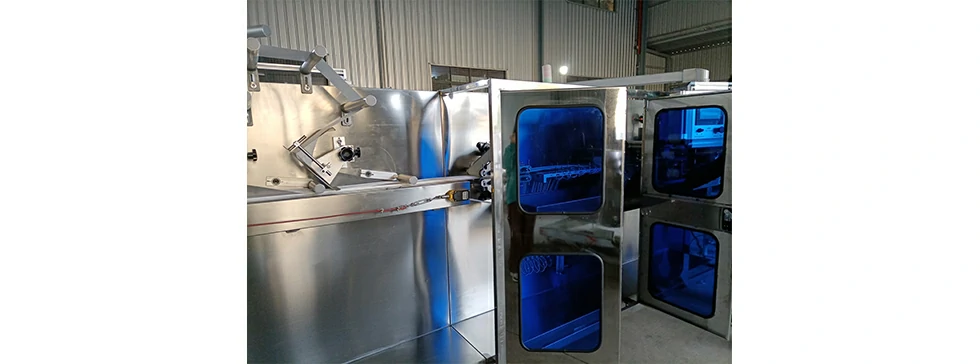In a non-woven disposable wet wipes machine, continuous feeding and placement mechanisms are crucial for uninterrupted production.
Here’s how the machine manages feeding and placement for continuous production:
- Material Feeding Systems: The machine is equipped with systems designed to continuously feed non-woven fabric rolls or sheets, which are the primary material for wet wipes production. These feeding systems ensure a steady supply of material to the production line.
- Unwinding and Tension Control: Non-woven fabric rolls are unwound and fed into the machine. Tension control mechanisms maintain consistent tension on the material to prevent wrinkles, tears, or misfeeds, ensuring smooth and continuous processing.
- Cutting and Folding: The machine’s cutting and folding mechanisms automatically cut the non-woven fabric into individual wipes of the desired size and shape. This continuous process enables the production of multiple wipes simultaneously.
- Solution Application: If the wet wipes require wetting with a solution, automated systems apply the liquid continuously onto the non-woven fabric in a consistent and controlled manner across the production line.
- Packaging Integration: As the wipes are produced continuously, they move seamlessly into the packaging phase. Packaging machinery integrates with the production line, receiving the wipes in a continuous stream for further processing into final packaging units.
- Conveyor Systems: Conveyor belts or systems transport the wipes through the various stages of production, ensuring a continuous flow from cutting and wetting to folding and packaging.
- Automation and Control: The entire process is automated and controlled by a central system that synchronizes the various components and stages of the production line. Sensors and control mechanisms regulate speed, alignment, and quality control for continuous operation.
- Capacity and Scalability: Machines are designed to handle high capacities and can be scaled according to production demands. 20 lanes wet wipes machinery This scalability allows for adjustments in production rates without compromising continuous operation.
- Monitoring and Maintenance: Regular monitoring of the machine’s performance and scheduled maintenance sessions prevent breakdowns, ensuring continuous and uninterrupted production.
By incorporating these continuous feeding, processing, and automation mechanisms, non-woven disposable wet wipes machines can maintain a continuous and efficient production flow, meeting the demand for high-quality wet wipes in a seamless manner.
What maintenance procedures are required for the 20 lanes wet wipes machinery?
Maintaining a 20-lane wet wipes machinery requires a combination of routine checks, preventive maintenance, and occasional servicing to ensure optimal performance.
Here are essential maintenance procedures:
- Regular Cleaning: Daily or periodic cleaning of the machinery, including wiping down surfaces, removing debris, and clearing any accumulated residue, ensures smooth operation and prevents contamination.
- Lubrication: Lubricate moving parts, such as conveyor belts, rollers, cutting blades, and folding mechanisms, according to manufacturer specifications to reduce friction and prevent wear.
- Inspect and Replace Parts: Regularly inspect machine parts for signs of wear, damage, or misalignment. Replace worn-out or damaged components promptly to avoid disruptions in production.
- Calibration and Adjustment: Check and calibrate sensors, cutting blades, alignment systems, and tension controls to maintain accuracy and consistency across the 20 lanes.
- Electrical System Checks: Periodic inspection of electrical components, such as wiring, connections, switches, and control panels, helps prevent electrical issues that could lead to downtime.
- Routine Maintenance Schedule: Implement a routine maintenance schedule based on the manufacturer’s recommendations. This includes tasks like belt tension adjustments, motor checks, and system diagnostics.
- Quality Control Checks: Perform regular quality control checks on produced wet wipes to ensure they meet desired standards. Use these checks to identify potential issues in the machinery that affect product quality.
- Operator Training: Train operators to perform basic maintenance tasks, recognize potential problems, and address minor issues to prevent larger breakdowns.
- Emergency Procedures: Establish protocols for handling emergencies or breakdowns to minimize downtime. Ensure that staff are trained in emergency procedures and have access to troubleshooting guides.
- Manufacturer’s Guidelines: Follow the manufacturer’s guidelines and recommendations outlined in the machine’s manual for specific maintenance procedures and intervals.
- Periodic Servicing: Schedule periodic servicing or inspections by qualified technicians to conduct in-depth checks, adjustments, and calibration for optimal machinery performance.
- Record-Keeping: Maintain detailed records of maintenance activities, repairs, part replacements, and inspections to track the machine’s health and identify recurring issues.
By adhering to a comprehensive maintenance plan that includes regular checks, cleaning, lubrication, part replacement, and adherence to manufacturer guidelines, the 20-lane wet wipes machinery can operate efficiently, reducing the risk of unexpected breakdowns and ensuring consistent production.
